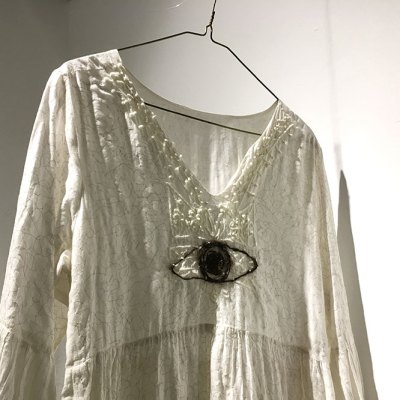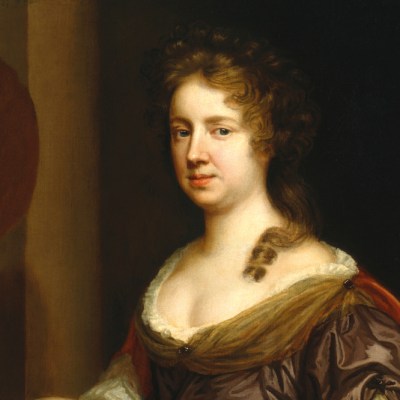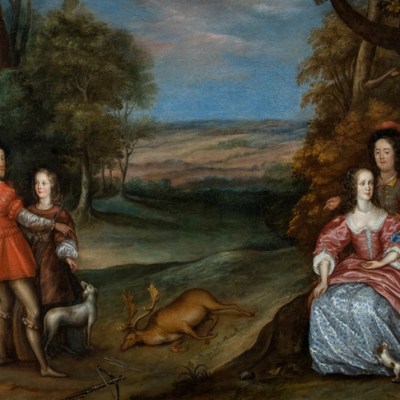Many of their works are undated. Some of their years of birth and death, or even their full names, have gone unrecorded. Few are remembered outside their own families. They are, as curator Deniz Artun puts it, artists ‘we can’t read about in history books’.
Despite her own background as a scholar of Turkish art, Artun says she had only heard of ‘perhaps one fifth’ of the 117 women represented in ‘I-You-They: A Century of Artist Women’ before she began putting together the show for Meşher, an exhibition space in Istanbul. ‘We wanted to understand who paved the way for contemporary artist women in Turkey who are successful today,’ Artun says, noting that she deliberately calls them ‘artist women’ as a way of emphasising their artistic rather than gender identity.
The 232 works in the show were all created by women living and working in Turkey between roughly 1850 and 1950, a period that spans the latter decades of the Ottoman Empire and the early years of the Turkish Republic. Ottoman artists began to adopt Western-style painting and sculpture in the early part of this era, and the works on display largely reflect that. They run the gamut of styles and mediums, including abstract oil paintings, finely detailed charcoal portraits, totemic terracotta sculptures, linocuts, pencil sketches and photographs.
The show takes its title from a work from 1993–96 by Turkish artist Sukran Aziz, a chessboard-like grid of foil-cut letters on wood spelling out ‘I-You-They’ in various languages. It is organised into three parts across three floors, each centred around one of the personal pronouns in the exhibition title.
Drawing (n.d.), Belkis Mustafa. Arkas Collection

Portraits and self-portraits fill the ground floor of Meşher’s historic building, themed around the idea of ‘I’. Some faces meet the viewer with a frank gaze while others appear masked, reflected in a mirror or erased entirely, as in a delicate but unsettling pencil profile sketch of a woman’s hair, ear, neck, shoulders and jawline, by the early 20th-century artist Belkis Mustafa.
Upstairs, the ‘You’ section juxtaposes depictions of family and motherhood with portraits of female performers and nude figures, such as the soft but muscular woman painted by Celile Uguraldim in 1949, in a posture recalling Rodin’s The Thinker. The goal, Artun says, was to get people to question ‘who decides that the mother’s body is sacred and the body of the odalisque is not?’ It also points to the ways in which even successful women have often seen their identities as artists eclipsed by their familial roles.
‘When women are mentioned in Turkish art history, they are always described in relation to someone else, as the mother or wife of a male artist, as if they were not able to become an artist on their own,’ says Ceren Ozpinar, a senior lecturer at the University of Brighton, whose research focuses on gender, identity and art in Turkey and the Middle East.
The first Academy of Fine Arts in the Ottoman Empire opened in Istanbul in 1882 – for male students only. An equivalent school for women was not set up until 1914, and arts education remained gender-segregated, with prohibitions in place on working with nude models of the opposite sex, until after the founding of the Turkish Republic in 1923.
Before the establishment of the women’s art school, ‘daughters of the bureaucratic elite were encouraged and supported by their families to delve into art as a hobby, but not as a profession,’ says Ahu Antmen, a professor of modern and contemporary art history at Sabanci University in Istanbul. (Similar limits were of course faced by women in other parts of the world, including Victorian England, as Ozpinar notes.)
‘I-You-They’ does include some figures who managed to make a more public mark on the Turkish art world, and others whose works have been rediscovered in recent years. The painter Fahrelnissa Zeid, a prominent member of modernist and avant-garde circles in London and Paris in the 1950s, is probably the best known internationally of these names, with a retrospective at Tate Modern in 2017 bringing renewed attention to her kaleidoscopic abstract canvases. Photography pioneers Yildiz Moran, Semiha Es (Turkey’s first female war photographer) and Maryam Sahinyan (the country’s first female studio photographer) are also featured, as is the painter Mihri Musfik, the first director of the School of Fine Arts for Girls when it opened in 1914.
Echo (1952), Yildiz Moran. Yildiz Moran Archive

But the exceptional success of these women only emphasises the discrimination they and their peers faced, says Ozpinar: ‘They are noted in histories of art as rebels, as extraordinary artists, while similar male artists are considered normal.’ The newly formed Turkish nation-state ‘favoured the visibility of women in society as a reflection of its cultural modernity’, says Antmen. ‘But when you look at how art history has been written, you quickly realise it has been written by men who do not really believe that women are equal in merit. They are [portrayed] as the enthusiastic “ladies” of the show, rather than equal counterparts in the field of art.’
Indeed, even after women were able to receive a full formal art education, they continued to face barriers to equal recognition. ‘For years, women graduates of the Academy of Fine Arts could not get jobs there other than as assistants to the professors,’ says Tomur Atagok, a Turkish artist and professor who began her career in the 1960s. ‘Museums prefer to exhibit works by artists who teach at the universities and they have been mostly male.’ Work by women artists is often still undervalued by collectors and commercial galleries in Turkey.
I-You-They (1993–96), Sukran Aziz. Fuat Yalin Collection

For Ozpinar, the roots of these inequities can be found in the way that art history is traditionally taught. ‘This historical idea of progress, of one exclusive club of artists influencing the next, has mainly been applied to individuals or groups – comprised mostly of male artists,’ she says. ‘When we look at women artists, it may be more helpful to think of them as a constellation, not a continuum.’ While some contemporary Turkish artists do cite female predecessors as inspirations and influences, they have often had to rely on their own research to learn about these figures.
The curatorial team at Meşher took a similar approach, focusing on ‘constellations’ or networks, to uncover the diversity of artists featured in ‘I-You-They’, which Artun hopes will spur further investigation into other forgotten women artists. ‘We started from the artists we did know, looking at their photos, their studio diaries, their exhibit invitation cards, who else their teachers had taught to find others,’ she says of the almost two-year-long research process that fed into the show. ‘In that way, one woman led to the next.’
Still Life (n.d.), Frumet Tektas. Courtesy Aylin Tektas

On the final (‘They’) floor of the exhibition, more than 100 works by 85 artists depicting flowers and trees are displayed salon-style, creating an impression of a sprawling garden of sunflowers, poppies, begonias and roses, neatly arranged in vases or bursting across their canvases. Many are the only known pieces by the artists represented, mostly loaned by their families, having never found a place in any public collection. ‘Painting a flower in a vase was the safest work, one women of a certain social class were expected to do, like playing a little piano,’ Artun says. ‘In some cases, no other artistic avenues were open to them.’
Since the 1960s and ’70s, women have grown more prominent in the Turkish art scene, both as artists and in senior positions in galleries and institutions, just as they have done across the world. But their predecessors remain relatively unknown. ‘The fact that we still feel the need to organise an exhibition on women artists shows that there is still a problem,’ Ozpinar says.
‘I-You-They: A Century of Artist Women’ is at Meşher, Istanbul, until 27 March 2022.


